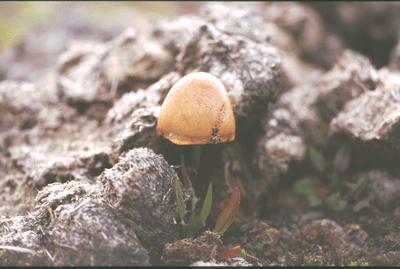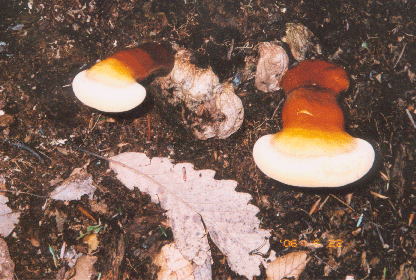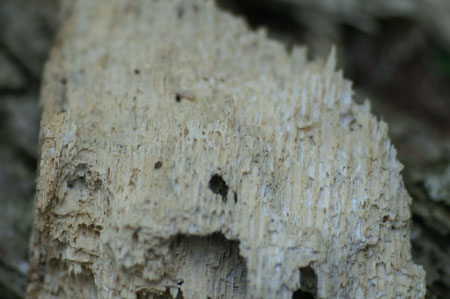White rot/Brown rot lesson
II. Saprotrophic fungi.
Saprotrophic fungi decompose diverse carbon sources. They have negative economic impacts when they attack substances that are produced and used by humans, such as fabric, leather goods, petroleum products, and especially food and wood products. Example: Serpula lacrimans (basidiomycete) is the infamous dry rot fungus, which causes damage to wooded buildings.
Fungi play a pivotal role in the decomposition of plant matter, where most of the carbon in terrestrial ecosystems is sequestered. Aerobic respiration by fungi returns much of this carbon to the atmosphere as CO2.
Psilocybe mushroom fruiting on horse dung.
One ecological group of fungi that decays plant tissues is the litter decomposers, which decay leaves and other relatively ephemeral substrates. Leaf litter is patchy, ephemeral, and heterogeneous. Litter decomposers employ different strategies to gain access to their substrates. Some reproduce quickly, producing many spores that can colonize news substrates, while others employ rhizomorphs, which allow them to explore the forest floor. Many mushrooms that grow on the forest floor are litter decayers. Examples: Gymnopus dryophilus, Marasmius sp. (basidiomycetes).
Another major ecological group is the wood decay fungi. Wood is composed mostly of cellulose, which is a polymer of sugars, and lignin, which is a complex, heterogeneous polymer that is made up of several phenol-containing compounds. Lignin is extremely resistant to decay. Fungi, mostly basidiomycetes, are among the few organisms that are capable of degrading lignin. Species that decay massive woody substrates produce the largest fruiting bodies in the fungi. Example: Inonotus dryadeus (basidiomycete).
There are two major categories of wood decay fungi:
1. White rot fungi are capable of degrading both lignin and cellulose. They leave the wood bleached and with a stringy consistency. White rot fungi can degrade diverse organic compounds besides lignin. They are therefore of potential use in bioremediation (reduction of environmental pollutants using living organisms) and biopulping (treatment of wood fibers in paper production). Example: Ganoderma lucidum (Reishi mushroom, basidiomycete).
Ganoderma lucidum, the reishi mushroom, a white rot fungus. Photo courtesy of Kelly Hallstrom.
2. Brown rot fungi degrade cellulose but leave the lignin behind. Brown-rotted wood has a crumbly consistency, breaking up into cubical fragments, and has a red-brown color. Brown rot residues are highly enriched in lignin and are very resistant to further decay they make up a major component of humic soils in some forest types. Examples: Piptporus betulinus, Fomitopsis pinicola (basidiomycetes). Serpula lacrimans, mentioned above, is also a brown-rot fungus.
Brown rot of wood (left) and white rot of wood (right).
.
Symbiotic Fungi--------Saprotrophic Fungi-------Carnivorous Fungi




